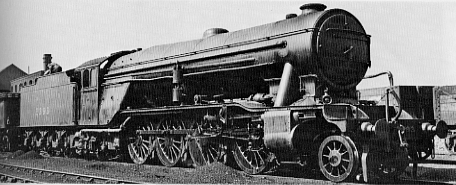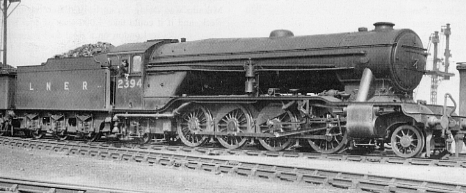The Gresley P1 Mineral 2-8-2 (Mikado) Locomotives

Even before Grouping (1923), Gresley was considering the design of a mineral locomotive more powerful than his O2 2-8-0. Initially, he considered a 2-10-2 design but this was changed to that of a 2-8-2 Mikado by 1923. This was submitted to the LNER Locomotive Committee in August 1923, for use between Peterborough and London, and between Immingham and Wath Yard. The power was quoted as being able to pull 25% more wagons than the 2-8-0s. This submission stated that sufficient loads could be found for these locomotives, but it appears that this was omitted from the meeting minutes.
By this time, Gresley was considering a booster on the trailing truck, and design work was contracted out to The Superheater Co. in New York. In May 1924, the Superheater Co. recommended Gresley's own recommendation of a Cartazzi truck for the booster. The Superheater Co. also recommended a "E Double" type superheater.
Locomotive boosters were first introduced in 1919 by the New York Central Railroad. The booster consisted of a smaller supplementary steam engine driving a trailing axle via an idler gear. The idler gear could be engaged when extra power was required, eg. when starting a heavy train. A booster had been ordered by the Great Northern Railway (GNR) just before Grouping, and this was fitted to C1 No. 4419. The boosters fitted to the P1s were very similar and with the same quoted tractive effort, but with a higher operating steam pressure.
The layout of the Walschaerts and Gresley valve gear was borrowed from the O2 2-8-0 design. Unusually for a Doncaster design, the P1s also had steam reversing gear, and steam brakes on both the engine and the tender.
No. 2393 was completed in June 1925, just in time for the Stockton & Darlington Centenary celebrations in July. It was fitted with a Robinson superheater, whilst No. 2394 (completed in November) had the "E Double" superheater recommended by The Superheater Co.
The two P1 locomotives were initially put to work hauling coal between New England and Ferme Park, which was the only route which could usefully use their haulage abilities. By 1926, they were still well thought of, with the Locomotive Running Superintendents recommending the replacement of four 0-8-0s with four new P1s. However, these would never be built.

The "E Double" superheater fitted to No. 2394 proved to be disappointing, and this was replaced by a Robinson superheater in 1931. By this time, the Robinson type had become the LNER standard superheater design.
Early trials demonstrated that the boosters were only really effective with loads of at least 1,600 tons. Typical P1 loads were much less than this, and the boosters were rarely used from the mid-1930s. The steam pipes to the boosters also tended to leak. This problem was never fully fixed. The boosters were eventually removed in 1937 (No. 2394) and 1938 (No. 2393).
The P1s were really only effective when hauling heavy trains of 100 wagons or so, with lighter loads resulting in high coal consumption. The main problem was that it was difficult to find this much work for them. 100 wagon trains had many problems due to the physical limitations of the route between Peterborough and London. With the combination of fast passenger and slow freight traffic on this route, congestion could be serious. With the numerous stops for the fast passenger trains followed by the re-starting of heavy loads; P1 coal consumption could still be very high. Eventually many of the bottlenecks would be converted to four-track sections; and from 1932 attempts were made to speed up the coal trains with K3 2-6-0 locomotives. But by this stage, only one 100 wagon P1 train was timetabled per day.
The boilers were interchangeable with the A1 and A3 type boilers, but the P1s kept their original boilers longer than any of the A1s. This may explain the extremely bad condition of No. 2393's boiler when it was removed in 1942. The Works Manager described it as 'the worst condition of any Pacific boiler I have ever seen'. Both P2s had their original boilers replaced with A3-type boilers in 1942.
By this point, Thompson's standardisation scheme was in full swing, and there was no long term place for these two locomotives. Both were withdrawn in July 1945. The boilers were used to rebuild Class A1 Nos. 2557 and 2565 to Class A3. The tenders were modified and used on two of the Thompson B2 locomotives.
Technical Details
The following details are for the P1s with their original boilers and Robinson superheaters. No. 2394 was initially fitted with a "E Double" type superheater, but this was replaced by the Robinson type in 1931. In 1942, both P1s were fitted with A3 boilers with 43-element superheaters. Hence, the following details represent both No. 2393 from 1931, and No. 2394 from construction in 1925; through to 1942. The boosters are also included, although these were removed between 1937 and 1938.
| Cylinders (x3): | 20x26in. | |
| Motion: | Inside: | Gresley conjugated |
| Outside: | Walschaerts | |
| Valves: | 8" piston | |
| Boiler: | Max. Diameter: | 6ft 5in |
| Pressure: | 180psi | |
| Diagram No.: | 94 | |
| Heating Surface: | Total: | 3455 sq.ft. |
| Firebox: | 215 sq.ft. | |
| Tubes: | 1880 sq.ft. (168x 2.25in) | |
| Flues: | 835 sq.ft. (32x 5.25in) | |
| Superheater: | 525 sq.ft. (32x 2.25in) | |
| Grate Area: | 41.25 sq.ft. | |
| Wheels: | Leading: | 3ft 2in |
| Coupled: | 5ft 2in | |
| Trailing: | 3ft 8in | |
| Tractive Effort: | (@ 85% boiler pressure) | 38,500lb |
| Booster: | Cylinders: | 10x12in (2x) |
| Tractive Effort: | 8,500lb | |
| Wheelbase: | Total: | 59ft 8in |
| Engine: | 36ft 2in | |
| Tender: | 13ft 0in | |
| Weight (full): | Total: | 151 tons 8cwt |
| Engine: | 100 tons 0cwt | |
| Tender: | 51 tons 8cwt | |
| Max. Axle Load: | 18 tons 13cwt |
Preservation
Both of the P1 locomotives were withdrawn in 1945, and neither survived into preservation.
Models
Crownline have produced a 4mm scale (OO gauge) kit of the P1, but this is no longer available.